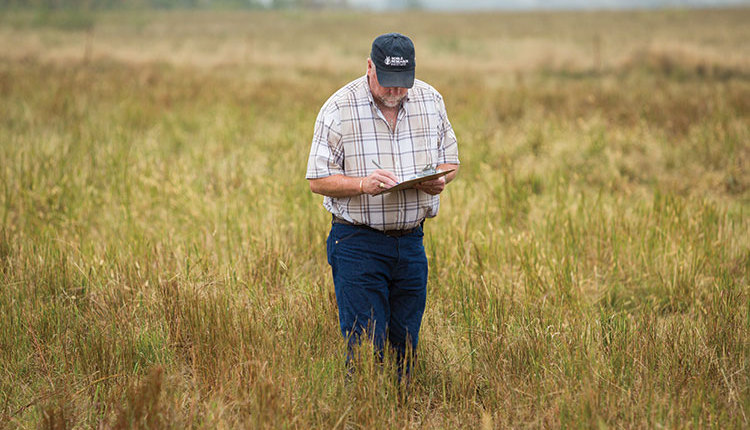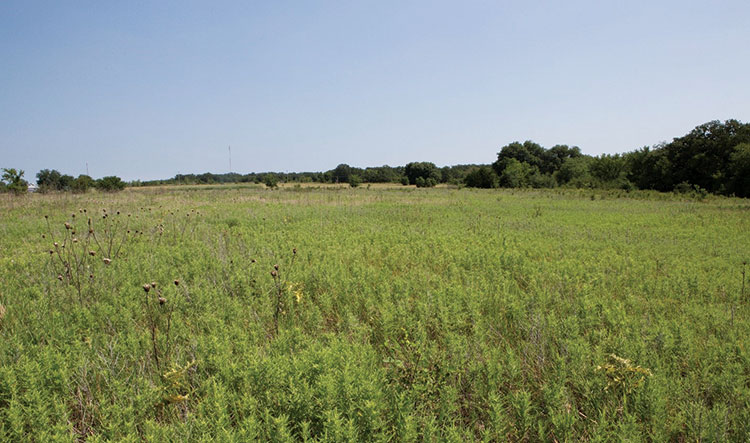The author is a planned consultation manager and senior soils and crops consultant with the Noble Research Institute in Ardmore, Okla.

The philosophies of regenerative agriculture, sustainable agriculture, and holistic agriculture are generating a great deal of interest these days. While in some people’s minds these systems equate to zero, or very few production inputs, in truth, they all use a variety of inputs that align with their objectives. An important component of each philosophy is following integrated pest management (IPM) principles to select the right tactics to address pest problems.
While there are numerous definitions of IPM, a good one offered by North Carolina State Extension is: “Integrated Pest Management is a sustainable approach to managing pests that combines multiple approaches, including pest prevention, avoidance, monitoring, and suppression (PAMS) in a manner that minimizes public health, economic, and environmental risk.”
Pests include any organism that can cause yield or quality losses. While insects, weeds, and diseases are the most commonly thought of pests, the same management principles apply to every pest — from microscopic parasitic nematodes to invasive trees.
Prevent the pest
Preventing a pest from becoming established in the first place is clearly the most effective approach to pest management, particularly in regard to invasive or non-native pests. If a pest is never established, it obviously cannot cause yield or quality losses.
Quarantines or exclusion zones are often the first line of defense when an invasive pest threatens. Should an invasive pest become established, implementing an aggressive eradication program to prevent the pest from persisting in the area may be necessary for effective long-term pest prevention.
Avoid the pest
Use sound cultural practices to keep an existing pest population below its economic or action threshold. A good definition of the economic or action threshold is “the pest density at which management action should be taken to prevent an increasing pest population from reaching the economic injury level.”
A few avoidance approaches for forages include:
- Maintain vigorous forage growth that competes with weeds and is able to withstand insects or diseases without significant yield or quality losses.
- Add a diversity of forage species to dilute insect host plants and reduce opportunities for weed establishment.
- Utilize forage species or varieties with genetic resistance to anticipated insects or diseases.
- Maintain populations of beneficial species to limit development of weed and insect infestations.
Monitor the pest
Characterize the presence or absence, identity, and distribution of pest and beneficial populations. Without monitoring, there is no way to know if pest or beneficial populations are present, if the beneficial population is adequate to suppress a pest population, or if a pest population is approaching the economic threshold.
A few methods for monitoring include:
- In-field, boots-on-the-ground scouting for weeds, insects, and signs of disease.
- Utilizing weather models to predict disease or insect outbreaks.
- Using traps to determine when insect pests are present.
Suppress the pest
Apply tactics to keep a pest below its economic or action threshold or return it to that level when the prevention and avoidance approaches have failed. Suppression tactics should not be implemented unless monitoring has shown they are necessary.
A few suppression tactics for forages include:
- Implement crop rotations to break disease or insect life cycles or allow use of alternative herbicides to control problem weeds.
- Add trap or cover crops to reduce anticipated insect or weed pressure.
- Time harvest or grazing events to disrupt insect or disease cycles.
- As a last resort, use synthetic or biological pesticides to manage weeds, insects, and diseases.
While synthetic and biological pesticides can be used in regenerative, sustainable, and holistic systems, they should only be used when their impact on non-target species and other side effects have been carefully considered. The pesticide application can be justified if the yield or quality losses caused by the pest exceed the economic or ecological value of the non-target or other side effects. However, a pesticide application is not justified if it will control the pest but also cause more harm than good in the big picture.
Find underlying causes
In addition to using an IPM philosophy when making pest management decisions, it is important to consider why a pest problem exists in the first place. Is the pest there because of management, or is it a threat that we have no control over?

A good example of a management-caused pest problem is a weed infestation due to overgrazing. Overgrazing exposes bare soil for an extended amount of time and gives weeds the space and sunlight to get established. If a good forage stubble height and solid sod cover are maintained, weeds don’t have the same opportunity to become a problem.
One example of a pest problem not caused by management is a fall armyworm outbreak. Fall armyworms do not overwinter in areas where it freezes. They migrate from south to north as repeating generations from the spring until a killing freeze occurs in their current location. A well-managed bermudagrass or wheat pasture, for example, is attractive to these breeding moths as they move north, and they will lay eggs. This can result in a population that could potentially exceed the economic or action threshold.
In this situation, there are no prevention or avoidance tactics to use, so we must use monitoring to determine if a suppression tactic is justified. If monitoring shows a suppression tactic is justified according to IPM principles, then that tactic, potentially including a pesticide application, is justified.
What is a pest?
While bugs crawling on your forage crop may concern you, are they really a pest if they aren’t causing yield or quality loss? It could be that they are benign or even beneficial insects.
Is a plant that is in your field but is not part of your intended base forage really a weed?
If it is causing yield or quality loss, then yes; it should be managed according to IPM principles. If it is a plant that contributes to forage volume or quality and can be grazed, then it contributes to your forage diversity and is not a weed. This is one reason why it is important to know the major plants in your pastures and their uses.
If you’d like help identifying your plants, you may be interested in our book, Grasses of the Great Plains: A Pictorial Guide. Find more information at www.noble.org/news/educational-publications.
Pest management in regenerative, sustainable, and holistic agricultural systems presents additional challenges compared to indiscriminate pesticide application programs. However, the potential economic and ecological benefits are well documented.
Two excellent sources for more information on IPM include the National Integrated Pest Management Database at https://ipmdata.ipmcenters.org and the IPM Institute of North America at https://ipminstitute.org.
This article appeared in the March 2021 issue of Hay & Forage Grower on pages 30 and 31.
Not a subscriber? Click to get the print magazine.

